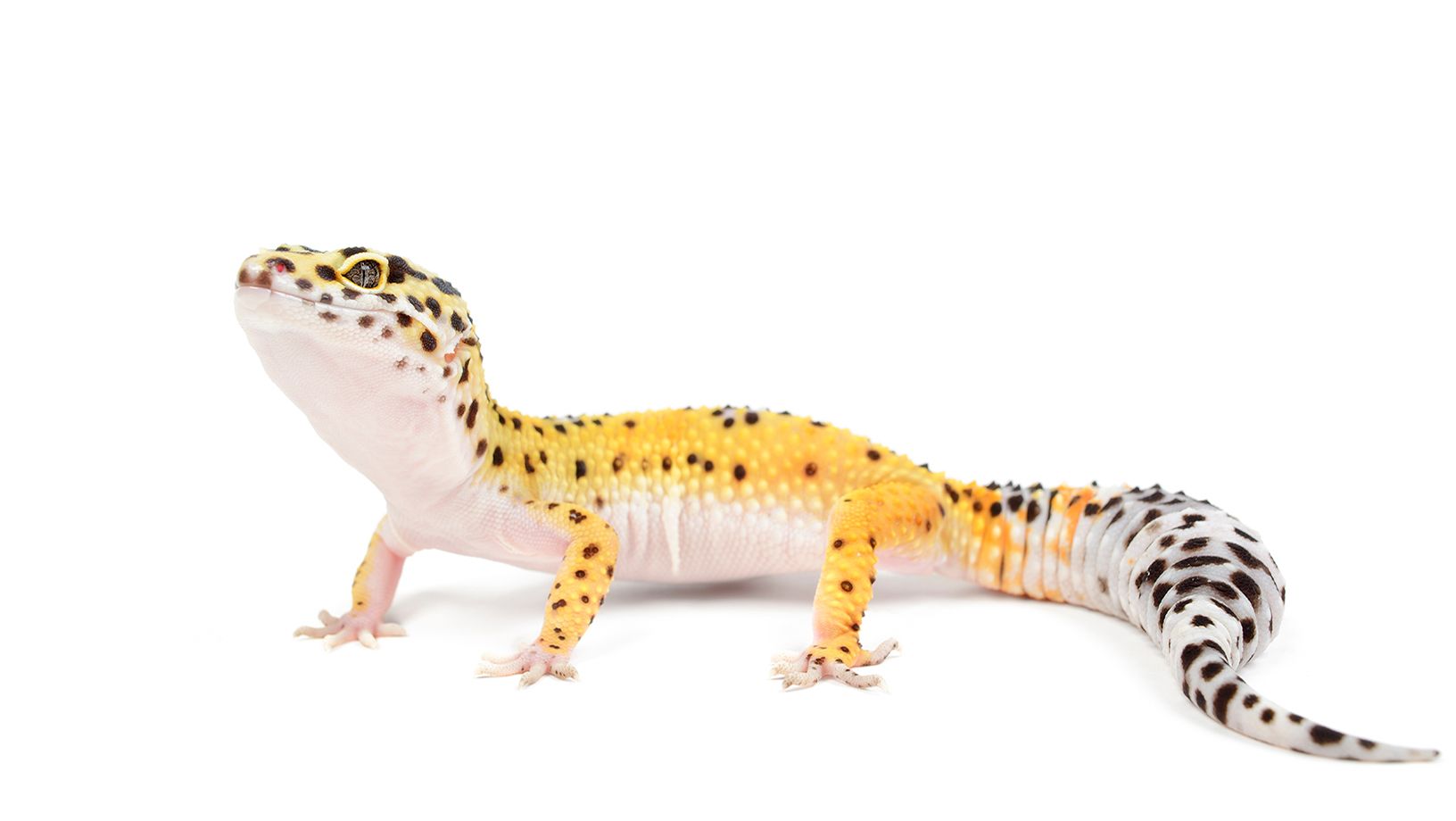Leopard Gecko Care Guide

In this Article
Spotted and stylish Leopard Geckos!
Leopard geckos are small, ground-dwelling lizards native to the arid regions of the Middle East and parts of South Asia. They are easily recognized by their yellow coloration with black spots, which resembles the patterning of a leopard. Selective breeding has produced a wide range of colors and patterns, often referred to as morphs.
These lizards are one of the most widely kept reptiles due to their manageable size, quiet behavior, and low space requirements. While they are typically calm and tolerant of handling, proper husbandry and environmental consistency are key to long-term health.
Leopard Gecko species profile
Size: Leopard geckos grow up to 10" (25 cm).
Lifespan: On average, they live for 15-20 years.
Behavior: Leopard geckos are nocturnal lizards meaning they are mostly active at night. Generally easy going, these lizards spend their days hiding under rocks and in burrows, then come out at night to feed.
Temperament: With regular interaction, they can become used to being held and handled. Leopard geckos do best housed alone as they can become aggressive with each other.
Setting up your habitat for your Leopard Gecko
A well-designed habitat supports natural behavior, helps regulate body functions, and reduces stress. Leopard geckos are terrestrial and do not climb often, so floor space and secure ground-level hides are more important than vertical height.
Substrate and enclosure setup
- Use a well ventilated terrarium with a screened lid to promote airflow
- Recommend using a 20-gallon terrarium at minimum, but bigger is better if you have the space.
- Avoid all loose substrates, including sand, bark, coconut husk, gravel, or soil
- These materials can cause impaction if accidentally ingested
- Spot clean daily and deep clean carpets or tile every two weeks
- Include rocks, branches and plants (real or artificial) for exploration and hiding.
- Ensure to include at least 2 hides, one on the warm side and one on the cool side of the habitat to allow your gecko to properly regulate their temperature
Lighting and temperature regulation
- Provide gentle heat: Use a low-wattage heat bulb, deep heat projector, or ceramic heat emitter to maintain a comfortable temperature.
- Nighttime temperature: If you use a heating element like a ceramic emitter, turn it off for 12 hours at night, as long as the ambient room temperature stays above 65°F (18°C).
- Lighting schedule: Always turn off lights at night to mimic natural day-night cycles.
- UVB lighting benefits: Recent studies suggest that UVB light can be beneficial for leopard geckos. UVB exposure helps them synthesize vitamin D3 naturally, which is essential to calcium absorption, and provides a light wavelength they can see—even though we cannot.
- Recommendation: While UVB lighting isn’t strictly required for survival, we recommend adding a low-output UVB bulb at the top of the enclosure (outside the mesh) to support overall health and well-being.
Temperature and humidity ranges
Leopard geckos require stable humidity and a temperature gradient, meaning a warm end and a cooler end within their enclosure. Use two thermometers, one on each side of the enclosure, and a hygrometer to monitor humidity. Adjust heating elements based on temperature readings, not guesswork.
On the warmer side, include a humidity hide filled with moist sphagnum moss (which should be changed weekly). This will aid your gecko with shedding since it will create a small environment that has very high humidity.
Zone | Temperature |
Cool side (day) | 75 to 80°F (23 to 26°C) |
Warm side (day) | 85 to 90°F (29 to 32°C) |
Basking area | 90 to 92°F (32 to 33°C) |
Night | 65 to 75°F (18 to 24°C) |
Humidity | 30 to 40 percent (cool side), 70 percent inside humidity hide |
Care and feeding
Leopard geckos are insectivores. They require a varied diet of live, gut-loaded insects that are appropriately sized for safe and effective feeding. Feeding routines should be adjusted based on the gecko’s age, activity level, and appetite.
What to feed a Leopard Gecko
Offer a rotation of gut-loaded insects, including:
- Crickets
- Dubia roaches
- Mealworms
- Superworms (for adults only and in moderation)
- Hornworms (as a moisture-rich treat)
Supplementation
Calcium and vitamin supplementation is essential to prevent metabolic bone disease and other deficiencies. Use powders specifically formulated for reptiles.
- Calcium powder (without D3): 2 to 3 times per week
- Reptile multivitamin:
- Once per week for juveniles
- Twice per month for adults
- Or as directed by a reptile veterinarian
Dust insects immediately before feeding. Uneaten, dusted insects lose nutritional value quickly and should not be reused.
Feeding frequency and portioning
- Juveniles: Feed once daily
- Adults: Feed every other day
- Only offer insects that are no longer than the width of your gecko’s head
- Remove any uneaten insects after 15 minutes to avoid stress or injury
Water access
- Provide a shallow dish of fresh water at all times
- Change the water daily and clean the dish frequently
- During warmer months or low-humidity conditions, increase misting slightly to help with hydration
Feeding safety
- Do not offer wild insects. These may carry parasites or pesticide residue
- Monitor your gecko’s weight and appetite regularly
- If your gecko refuses food or powder diet for more than one week, check habitat conditions and consult a reptile veterinarian.
When to see a vet
In addition to regularly scheduled appointments, contact your reptile veterinarian if you notice the following signs:
- runny droppings for more than two days
- decreased frequency in droppings
- hiding more than usual
- eating or drinking less; weight loss
- swollen joints or reluctance to move
- discharge from the eyes, nose or mouth
- shedding problems; discolored skin
- increased basking time
- thinning tail
Go to “find a vet” on arav.org for help finding a reptile veterinarian in your area.
NOTE: Most, if not all, reptiles carry Salmonella bacteria in their intestinal tract and intermittently or continuously shed these bacteria in their feces, so they are unsuitable pets for very young children and those with compromised immune systems. Good hygiene must always be practiced around all reptiles, and hands should be washed before and after interacting with reptiles.
SHOPPING CHECKLIST
- 20-gallon terrarium or larger with good ventilation
- screened lid
- UVB 3-5% bulb and fixture
- daytime and nighttime basking bulbs
- under-tank heater
- habitat thermometer(s) and a hygrometer
- reptile bedding/carpet
- artificial/natural rock or wood hide
- humidity hut
- sphagnum moss for humidity hut
- branches for climbing and hiding
- water bowl
- food bowl
- crickets, dubia roaches, hornworms, mealworms and/or superworms
- calcium powder
- multivitamin powder.
Ready to learn more?
This guide is a great starting place, but we encourage you to do more research on the individual species that you are keeping so that you can be as successful as possible! Related guides:
FAQs
How often should I feed my leopard gecko?
Juveniles should be fed daily. Adults typically eat every other day. Watch for signs of appetite changes around shedding or during seasonal shifts. Always remove uneaten prey after 15 minutes to prevent stress or injury.
What size insects are appropriate?
Feeder insects should be no longer than the space between your gecko’s eyes, which is roughly equal to the width of their head. Larger prey can cause choking or impaction.
What does dusting feeder insects mean?
“Dusting” means coating live insects in a fine layer of powdered supplements before feeding. Use calcium powder without D3 two to three times a week, and a reptile multivitamin once a week for juveniles and twice per month for adults. This supports bone health and prevents metabolic disease.
Do leopard geckos need UVB light?
Low-intensity UVB is recommended but not required. It supports calcium absorption and overall well-being, especially in geckos that are not consistently supplemented or that are breeding. Always choose a bulb rated for low-output use with nocturnal reptiles.
Why is my gecko spending more time in the humidity hide?
This is normal, especially during a pre-shed cycle. The humidity helps loosen skin and reduce the risk of retained shed. If your gecko spends most of its time there long after shedding, check the enclosure’s overall humidity and temperature levels.
Can I house more than one leopard gecko in the same enclosure?
No. Leopard geckos are solitary and territorial, especially males. Housing geckos together can lead to aggression, injury, or stress-related health issues. Always house them separately.
How can I tell if my leopard gecko is dehydrated?
Signs include sunken eyes, wrinkled skin, dry mouth tissue, or lethargy. Ensure the water dish is always full, the humidity hide is functioning properly, and your gecko is eating hydrated feeder insects like hornworms. Contact a veterinarian if symptoms persist.
What does abnormal shedding look like?
If old skin remains stuck on the toes, tail, or around the eyes, it may indicate low humidity or a health issue. A functioning humidity hide, proper temperatures, and good nutrition help support complete sheds.
When should I see a veterinarian?
See a vet if your gecko is not eating for several days, loses weight, shows signs of shedding problems, has runny or absent droppings, develops discharge, or becomes lethargic. A thinning tail is also a serious warning sign. Always consult a reptile-experienced veterinarian.

